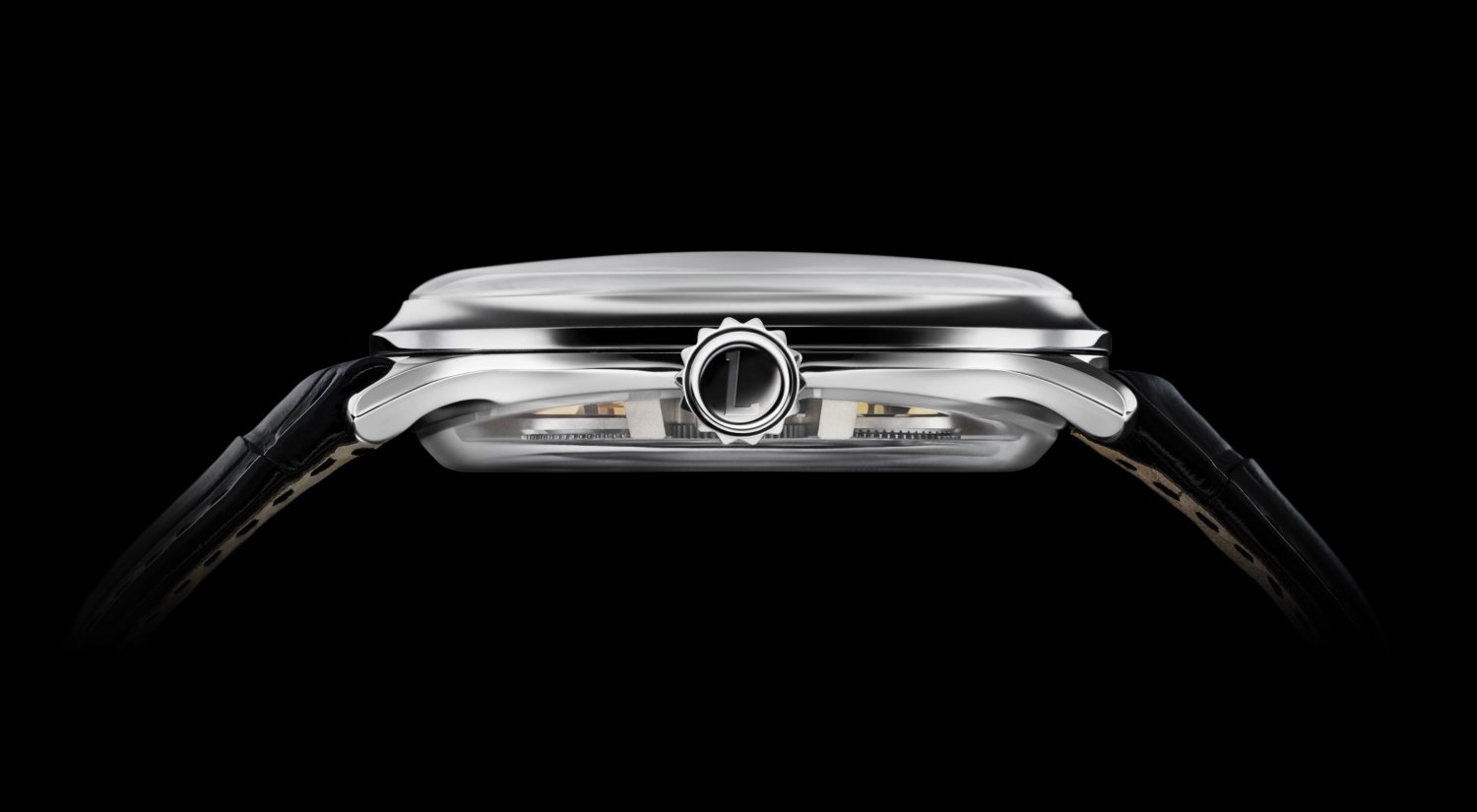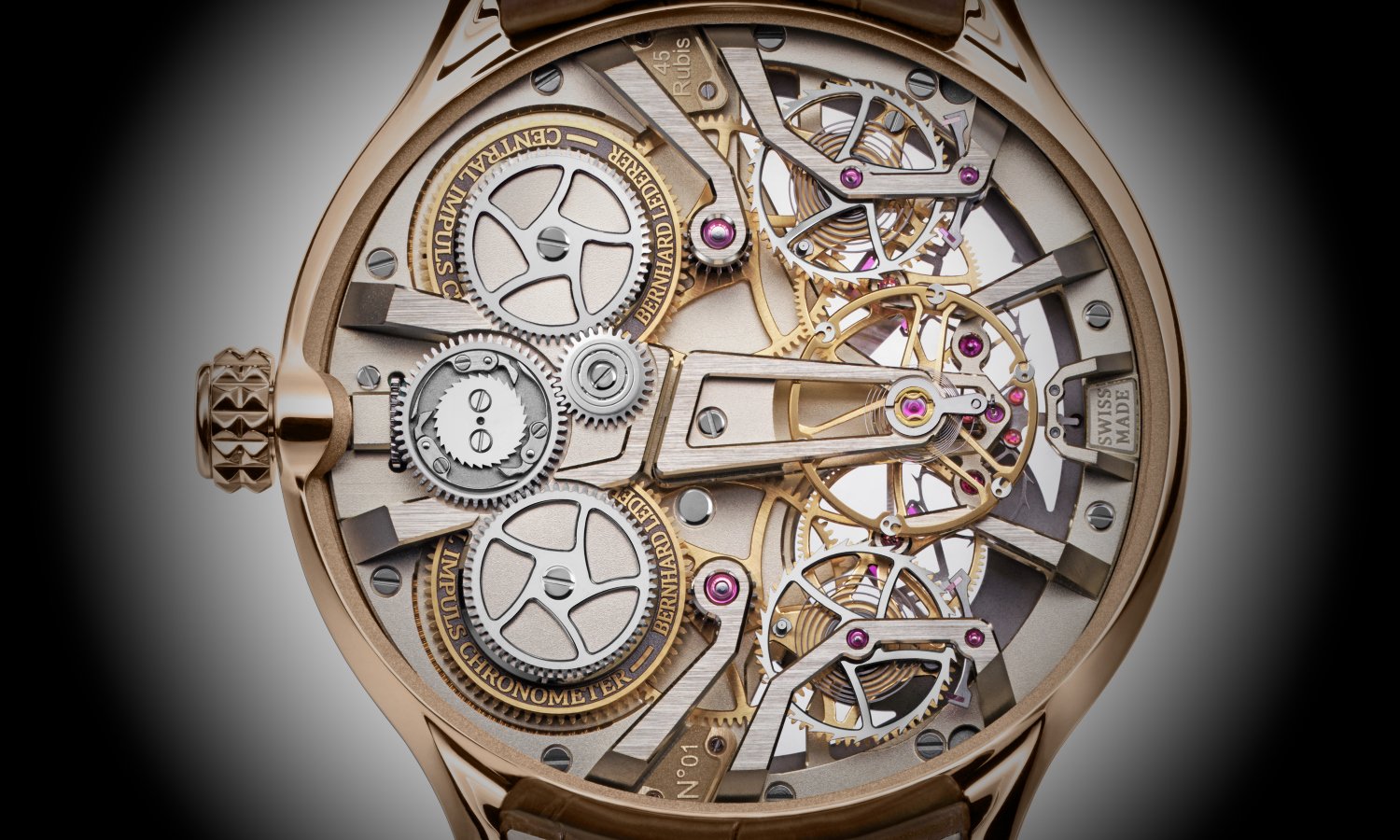fter years of research, Bernhard Lederer, incidentally one of the first members of the AHCI (Académie Horlogère des Créateurs Indépendants, an association with the mission to perpetuate the art of independent watch and clockmaking), brings to fruition the principle of the natural escapement with two 10-second constant-force mechanisms as conceived by John Harrison in 1756.
The Central Impulse Chronometer is a sleek watch with a movement of exceptional complexity, the result of unimagined development efforts and a testament to the noblest of legacies.
Once again the watchmaking and aesthetic world of Bernhard Lederer finds its expression in a new high-precision chronometer. The first Bernhard Lederer watch of the ‘Tribute to the Masters of Escapements’ collection comes in a case that has a diameter of 44 mm and a thickness of 12.2 mm. In it the award-winning German watchmaker has placed the fruit of years of reflecting upon and exploring the escapement, one of the most complex and noble subjects in watchmaking. The result is Central Impulse Chronometer whose movement has a natural escapement.
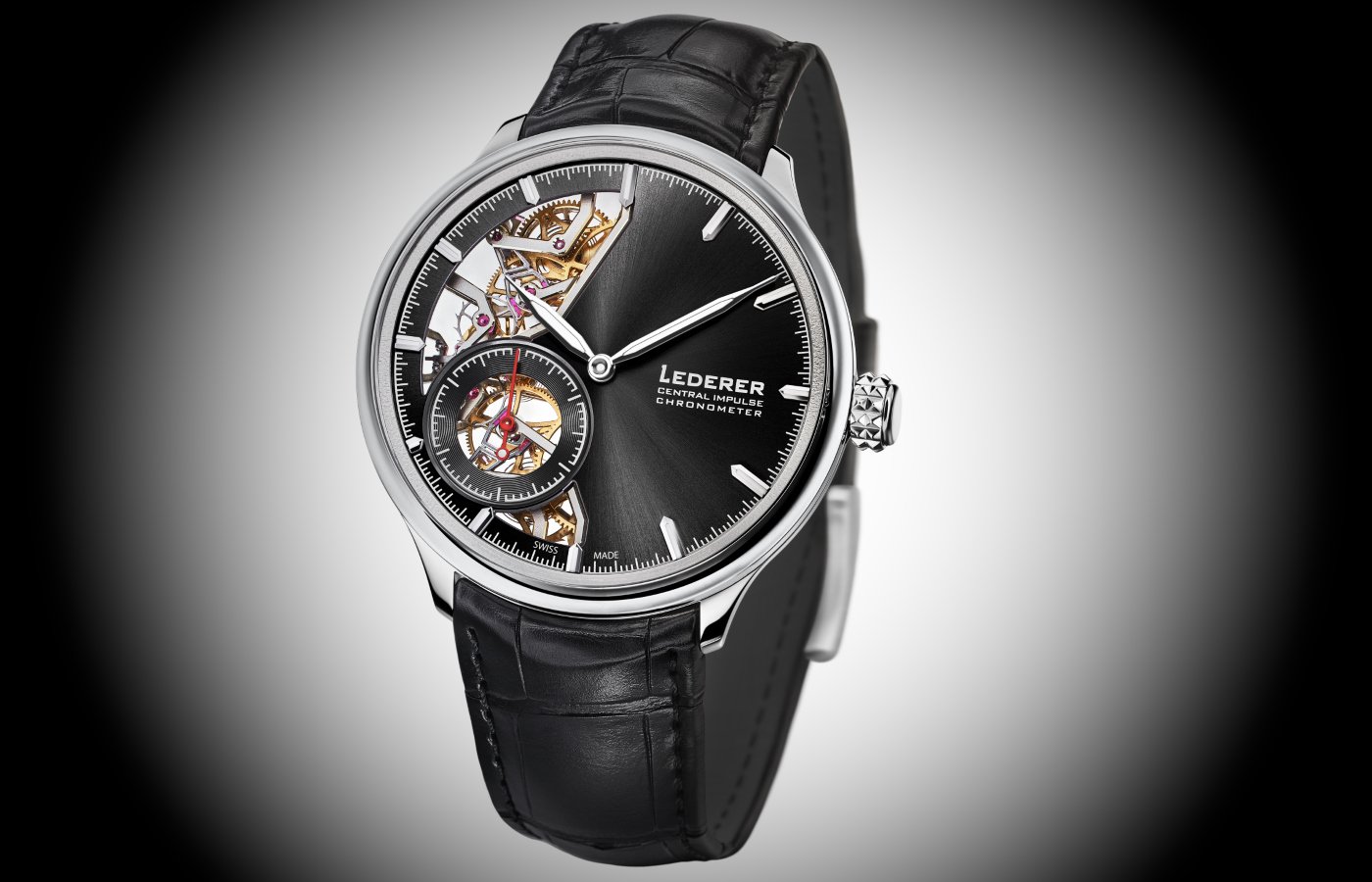
A journey completed
Drawing on nearly 40 years of experience and the resources of his workshop in St Blaise near Neuchâtel, in the cradle of Swiss watchmaking, Bernhard Lederer completed the work on the natural escapement initiated by George Daniels, who himself had taken over where Breguet left off. The Central Impulse Chronometer escapement is the ultimate, reliable and stable embodiment of the mechanical movement’s counting and regulating system designed by the English watchmaker.
It is composed of two escapement wheels operating in alternation and connected to an anchor that is absolutely one of a kind. Its profile, rubies, angles of lift, even the way it comes into contact with all the components it guides, make this an exceptional creation. Not least because the contacts are so light and gentle that the escapement is remarkably quiet, whilst emitting a unique sound every 5 seconds each time one of the two alternating constant force remontoires springs into action.
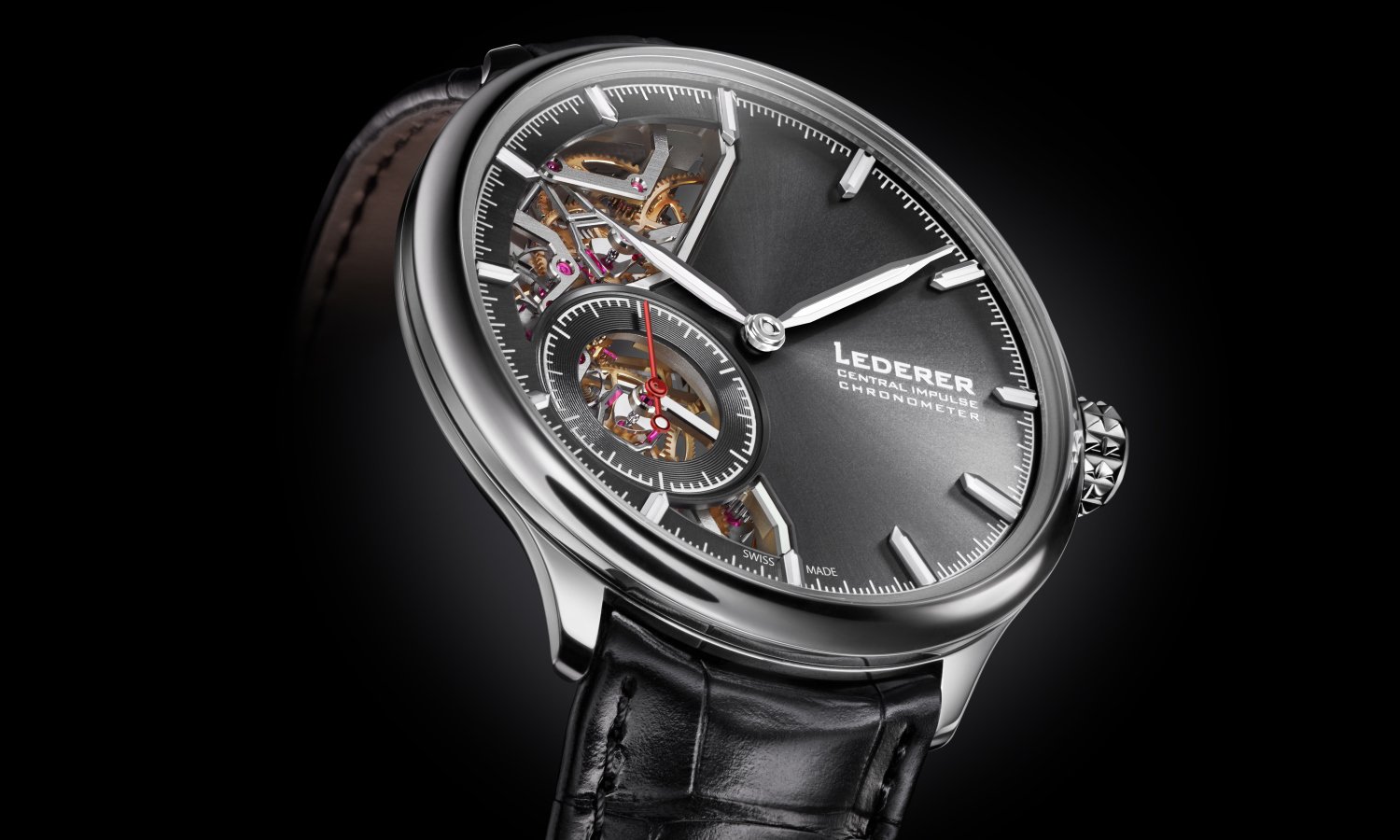
Virtuous optimization
To achieve the precision of his Caliber 9012, Bernhard Lederer installed these two escapement wheels at the end of two separate gear trains, each with its own barrel and its own 10-second constant force remontoire. In finely evening out the driving force, optimizing the geometry of the escapement parts, paring down the weight of these energy-intensive components, and reducing the internal friction of the escapement to a minimum, Bernhard Lederer has achieved an extraordinary degree of watchmaking perfection. It is a work deeply rooted in respect for the noblest traditions of watchmaking, with a level of finishing to match.
Simplicity in sophistication
Yet all this sophistication remains elegantly subtle. The Central Impulse Chronometer comes in the form of a watch in a sleek, understated round case in rose gold with a smooth bezel. The dial is vast, minimalist in its markings, save for a small seconds at 8 o’clock with a circular finish. For those who prefer a more visible technicality, Bernhard Lederer offers a second version in white gold with a slate grey sunburst openworked dial. It offers views of the final part of the gear train, the remontoires and the escapement, i.e. the distinctive core of the Central Impulse Chronometer.
The Central Impulse Chronometer escapement
By the time Bernhard Lederer took over from Daniels, he had already spoken with him on many occasions. As a tribute to the master, and through him to Breguet, he set about completing the work begun by Daniels and adapting it to a wristwatch, with all the challenges this would entail.
A frequency of 3 Hz was chosen because a watch worn on the wrist is subjected to countless shocks of varying intensity. Each one has repercussions on the movement’s regulating organs, i.e. the escapement wheels, but more importantly on the balance wheel with its spiral spring. With each impact, there is an acceleration or a slow-down, and the components find themselves twisted in their plane. They must therefore resume their intended course as quickly as possible, which is a sine qua non for precision under everyday wear conditions.
In addition, the escapement is a system that spends most of its time at a standstill. Whilst the balance wheel is in perpetual rotation, it only activates the anchor at the end of each oscillation: when it has the highest velocity, i.e. the greatest force, and thus the best capacity to drive the mechanism. The anchor and anchor wheels are in a constant stop and go, accelerated and decelerated, which consumes energy and impairs isochronism and therefore precision.
The incredible lightness of overcoming inertia
To overcome these problems intrinsic to any escapement, the Central Impulse Chronometer uses components made from titanium instead of the more traditional steel. Lighter, stiffer and with a lower inertia, they are quick to restart and much more energy-efficient. In other words, the balance wheel’s rhythm remains virtually unaffected by the contact with the anchor.
It receives the force necessary for each impulse, itself an assurance of isochronism and therefore of timekeeping precision. The quantity of energy delivered is also controlled further upstream, in the gear train. Bernhard Lederer installed two independent gear trains, one for each escape wheel. Each of these kinetic chains has its own dedicated barrel. What is more, Bernhard Lederer inserted a constant force remontoire.
The strength of soft power
The constant force remontoire consists in accumulating an energy buffer in a spring similar to the one in the barrel, but one that is much shorter and lighter. Recharged in 10-second intervals, it capitalizes on the fact that the force of an unwinding spring is stronger when it is tightly wound up, and weaker when it is almost completely unwound. This variation in torque has a direct impact on isochronism. The remontoire equalizes the force by ensuring a very homogeneous torque profile, with extremely minute variations in the energy delivered to the balance wheel. Here, Bernhard Lederer chose a design similar to the one invented in 1756 by John Harrison, where the remontoire recharging interval is managed by an anchor with a specific profile.
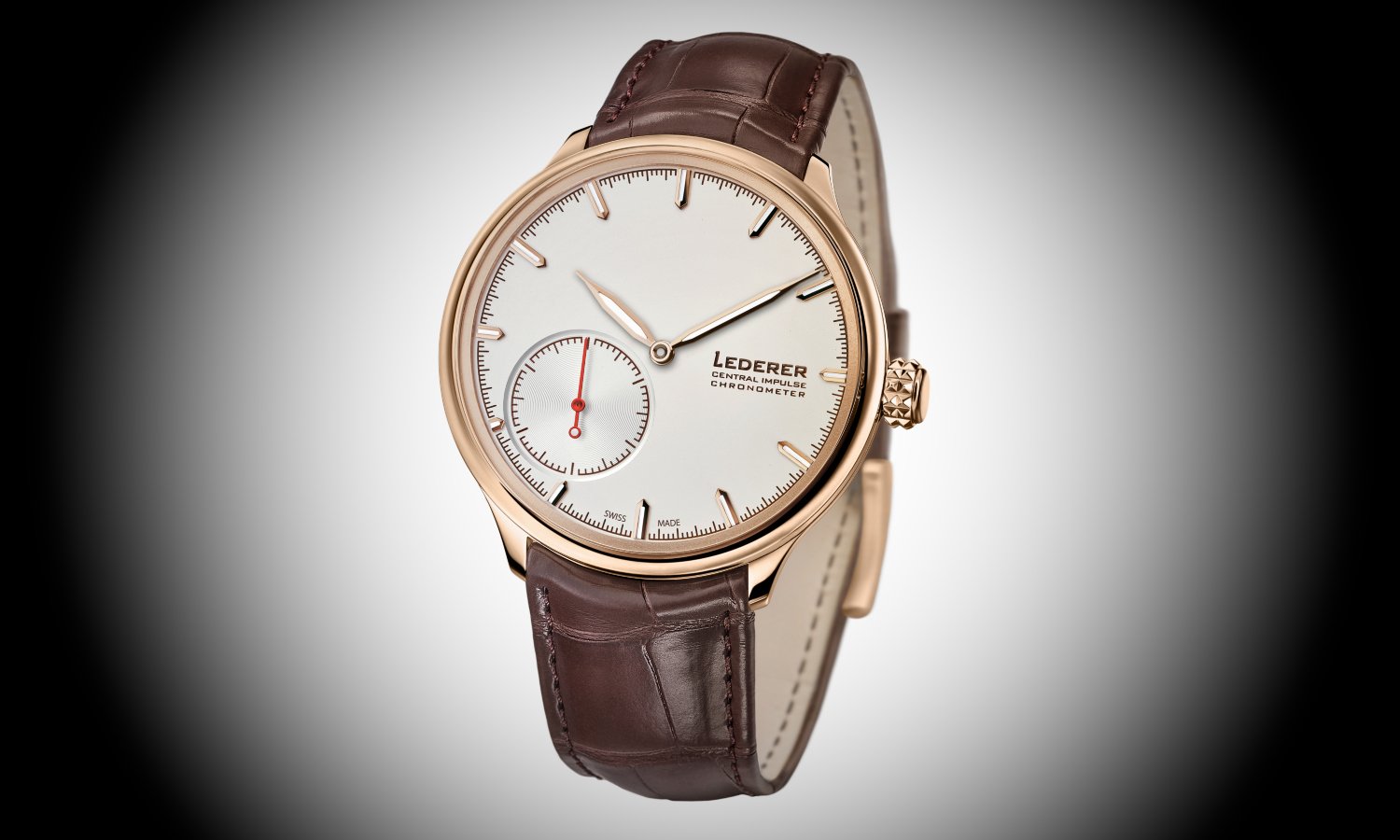
Acting on ideal impulse
At a more fundamental level, the mechanical specificity of the Central Impulse Chronometer escapement lies in its anchor. It is the interface between the two escapement wheels, i.e. the gear train and the balance wheel. As the metronome, as it were, of the timepiece, it is where the energy of the former is transformed into the time information delivered by the latter. To improve performance, the Central Impulse Chronometer’s anchor presents more points of contact between the components – whose shape, too, has been optimized. In particular, Bernhard Lederer has added a minutely small ruby, with a concave cut in the center, which advances the moment of contact between the escapement wheel tooth and the balance wheel impulse pallet.
Indeed, this is the most remarkable feature of the Central Impulse Chronometer: the manner in which it manages the moment and the contact surface of the impulse on the balance wheel. The impulse is direct and in alignment from the escapement wheel to the balance wheel, therefore theoretically perfect. In addition, control of the impulse position is constant over time, both at low and high amplitude of the balance wheel. In fact, due to the geometry of the receiving pallet, the anchor will be able to give an indirect impulse to the balance wheel, allowing it to be always in the desired position when the direct impulse is given. As a result of the force being transmitted in this position, shocks are attenuated and the balance wheel receives the impulse in such a way as to ensure optimum isochronism and stability.
Gently does it
The concrete effect of this ingenious arrangement: fewer shocks between the components, smoother transfers of energy. The driving force is effectively dampened, though not in its intensity, but instead at the point of contact. It is when the escapement wheels and the balance wheel connect that the heartbeat of the watch, the ticking sound, is generated. These ever so slight impacts have been further mitigated to a degree that the Caliber 9012 is surprisingly quiet. George Daniels, an expert in vintage automobiles and an admitted petrol head, would have appreciated how the movement purrs like a well-tuned engine. This ‘engine’ is so well tuned that one hardly hears it.
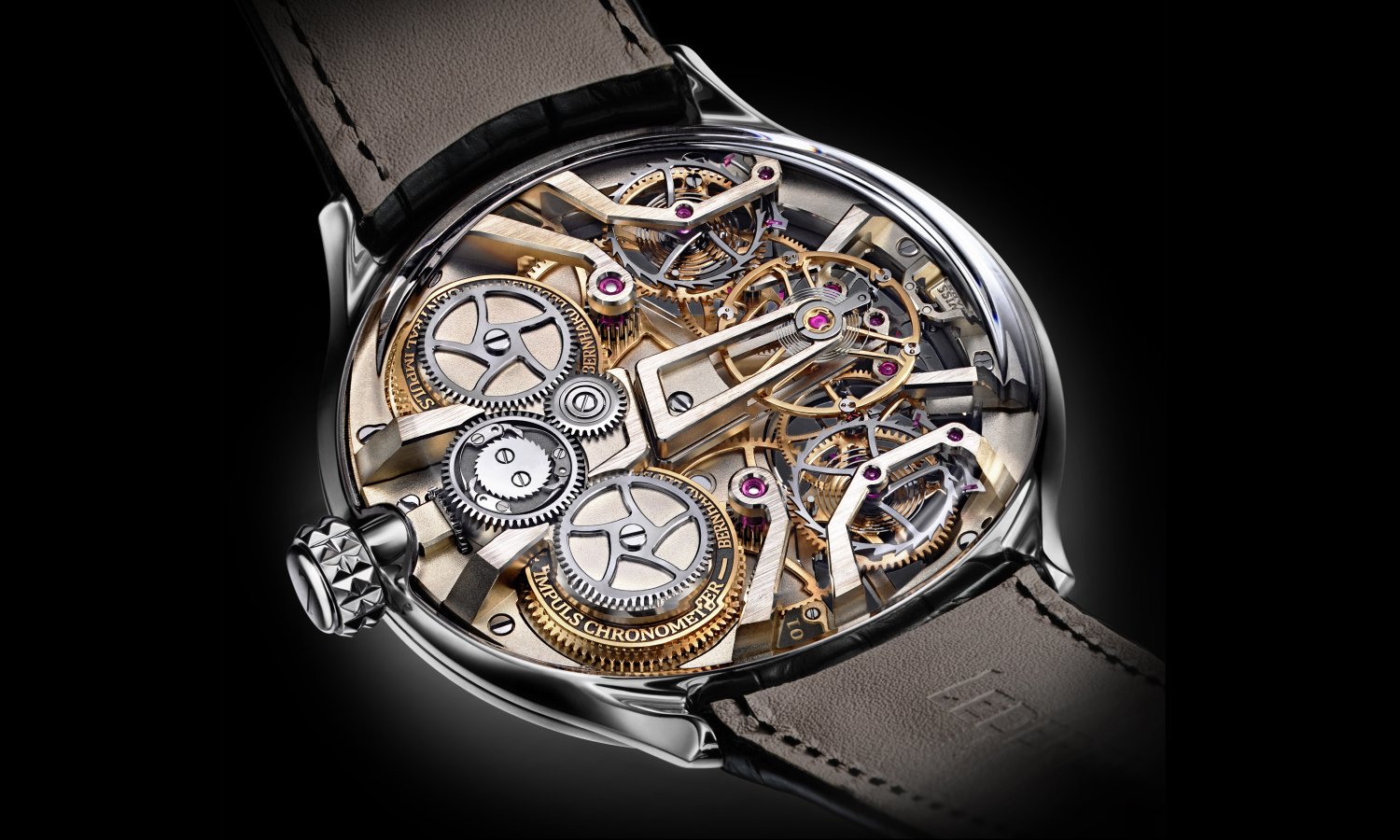
The elegance of an authentic chronometer
As a complement to his technical mastery, Bernhard Lederer has a particularity sensibility for design, having time and again distinguished himself in this regard. The Central Impulse Chronometer is no exception as it opens a new chapter in the watchmaker’s aesthetic language. The sleek, 44-mm round pink gold case is elegantly understated. Its fine, smooth bezel emphasizes the vastness of the light grey, opalescent dial with a signature at 3 o’clock and raised beveled indices featuring a touch of SuperLumiNova™. The shape of the rose gold beveled hands, a hybrid of leaf and baton, underscores the Bernhard Lederer aesthetic signature. Challenging the symmetry, a large-diameter, circular-finished small seconds subdial at 8 o’clock.
Visible or invisible, the sophistication remains
The Central Impulse Chronometer is also available in a white gold with an openworked slate grey sunburst dial. The generous window provides an unobstructed view of the Caliber 9012 and its most distinctive features, namely the remontoires and escapement. It is the ‘technical’ counterpart to the ‘minimalist’ rose gold version, whose complexity remains hidden from view until the watch is turned over. Here, a sapphire crystal case back reveals the architecture of the Caliber 9012, which is symmetrical, angled, widely openworked and quite large at 39.3 mm in diameter. On the white gold version, the skeletonized remontoire, gear train, escapement and balance wheel bridges featuring slender geometrical shapes are all visible – a contrast to the, shall we say, more restrained Central Impulse Chronometer ‘Tribute to the Masters Of Escapements’ in rose gold.
Relentless attention to detail
Bernhard Lederer’s aesthetic signatures can be seen and sensed in every nook and cranny of this generously sized, spectacular caliber whose two immense barrels, highlighted with fine gold, stand out throughout the movement. The wheel spokes are tangent curves with a unique profile, yet another Bernhard Lederer hallmark in a particular aesthetic universe that is not lacking in them. Naturally, the level of finishing matches the engineering prowess at the core of the Central Impulse Chronometer. The polishing, inward and outward angles, microbead blasting, engraving, graining… The surfaces, too, alternate between matt and mirror polished, enhancing the visual separation between the different levels, and therefore the perception of depth and substance of the movement.
A first pinnacle in a chain of pinnacles
The Central Impulse Chronometer, the first chapter of the ‘Tribute to the Masters Of Escapements’ collection, is a complete watchmaker’s work, where mechanical achievement finds itself amplified by the sophistication that went into the finishing. In this regard, Bernhard Lederer follows through in the footsteps of Breguet and George Daniels, and lays his own. Engineering prowess remains the foundational core of the Central Impulse Chronometer.
The result of several years of intense reflection and work, the Central Impulse Chronometer is a testament to Bernhard Lederer’s sincere admiration for George Daniels, reflected in a scrupulous respect for the master watchmaker’s approach. To have succeeded in bringing this chronometer into being is the pride of a humble human, a conscientious watchmaker and a discreet designer.


